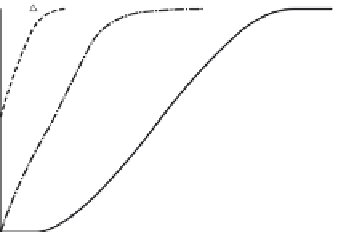Environmental Engineering Reference
In-Depth Information
Fig. 7.12
Results of a
population viability
analysis of an island
population of New
Zealand woodpigeons.
In the absence of
predator control, the
population is predicted
to go extinct within 100
years. Only at the
highest levels of
predator control
(equivalent to removing
all mammalian
predators) is the
population safe enough
to take a small annual
harvest of the pigeons.
(After Keedwell, 1995.)
100%
Predator control
None
Low
Medium
High
0%
0
10
20
Number of kereru harvested each year
few small but mature animals are likely to provide a disproportionate number of
offspring to the next generation and, as long as size-at-maturity is heritable, future
generations will be dominated by smaller fi sh. This is evolution in action and the
process is the same as that described for evolution of resistance to pesticides (Box
6.1, Figure 6.3).
Does this pattern of evolution actually happen in harvested populations? Appar-
ently yes. On Ram Mountain in Canada, for example, trophy bighorn rams (
Ovis
canadensis
), the ones that hunters most prize, now have smaller bodies and horns
(Figure 7.13a,b). Similarly, the size at which cod mature suffered a dramatic decline
between 1959 and 1979 in the north Atlantic (the solid circles in Figure 7.13c). In
both cases there is strong evidence that the changes were evolutionary responses to
size-selective harvest. Thus, for example, actual changes in the cod population are
closely paralleled by simulations where size-at-maturity is assumed to be herit-
able, but not when it is determined simply by random environmental factors
(Figure 7.13 c).
These evolutionary changes are of more than passing interest to harvest managers
because evolution of earlier maturation threatens the size and long-term sustainabil-
ity of yields. Individuals that mature earlier invest less in growth - so biomass yield
declines - and, being smaller, they have lower reproductive outputs overall - so the
population is less able to compensate for harvest mortality. We can draw an analogy
with foresters and farmers. These would be ridiculed if the seeds they planted each
generation were taken from the smallest, least productive parents available. Harvest-
ers of wild animals, when they selectively remove the largest and most productive
animals are basically doing what the farmers and foresters avoid - producing suc-
cessive generations that are smaller and less productive.
What lesson can managers take from these results? In essence, they should follow
the practice of indigenous fi shers such as those in Hawaii, and throw back both the
largest and the smallest individuals. The trouble, as I have already noted, is that net
and line fi shers catch (and damage) fi sh before their size is known. In these cases,
setting aside nonharvested areas, where large fi sh are safe, may sometimes be the
appropriate option.
Baskett et al. (2005) used population simulations to ask a number of questions
about how to avoid evolution and reductions in sustainable yields. They found, for
example, that setting up nonharvested areas could protect both size-at-maturity and
yield, but only in fi sheries that are already heavily exploited. On the other hand, in













































Search WWH ::

Custom Search